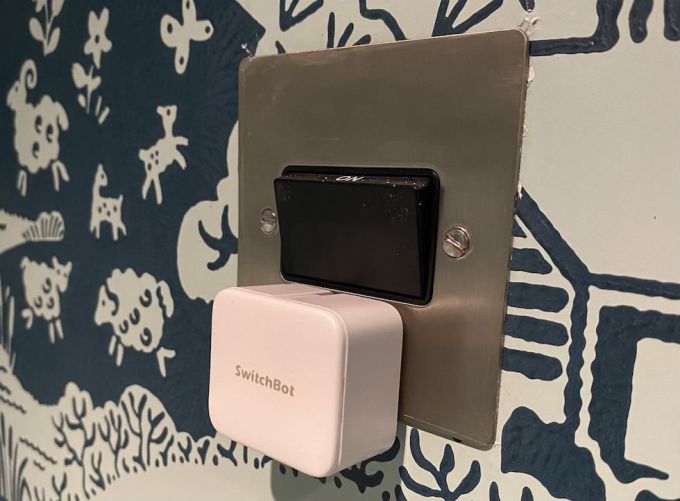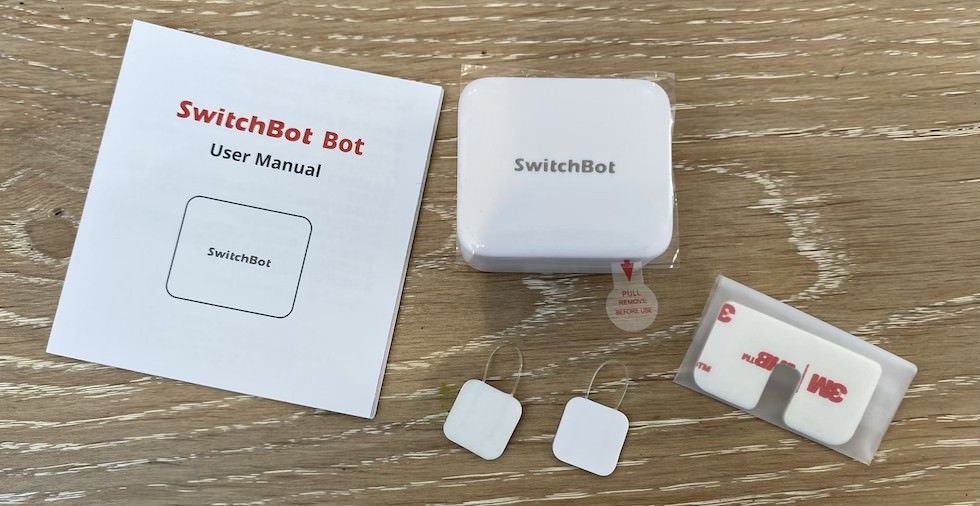Disclosure: We were provided this product by SwitchBot free of charge to use and review. That does not influence our views. At no additional cost to you, we earn a commission if you click through to one of our recommended products and make a purchase.
As you'll know from my previous reviews of smart products you'll know I'm slightly obsessed with making my entire house smart. From the heating to blinds, lighting to AV, I'm on a mission to do it.
With my current setup, there are certain circumstances where I just need something to turn on a switch. Unfortunately, there are loads of times when a smart plug falls short. I'm sure many of you will be familiar with situations like that. Cue the SwitchBot Bot!
This is my first time using a SwitchBot product, and I'm keen to give them a whirl. Alongside the Bot, they make loads of other exciting products, including motion sensors, cameras, lighting and even the SwitchBot Curtain that you attach to your curtain rail and make your curtains smart. How cool is that?!
SwitchBot Bot Review
My use case for the Bot is pretty niche, and I understand it has many more uses. However, this issue has been niggling me for a long time, and the Bot is the only thing that can handle it (short of loads of expensive electrical work). I'm sure I'm not alone, but first, let me tell you how the Bot works, how to set it up, the pros and cons etc., and then I'll talk you through my particular need for it.
What does the SwitchBot Bot do?
Simply put, it's a little device that physically switches devices and appliances on and off for you. It's a bit bigger than a matchbox and has a little robotic arm that can push buttons and switches. It's strong, too and is designed to work with a wide range of buttons, including light switches, power buttons, coffee makers, air conditioners, and more.

There are two modes for the Bot. Press Mode and Switch Mode. If you're simply pushing a button on or off, you'll need Press Mode. That's for things like turning your Mac or coffee machine on. Then there's Switch Mode which elevates the Bot to another level. You connect one of the adhesive pads with a hook (they call this the Add-on) to a switch and the robotic arm, and the Bot can now turn a light switch or any rocker switch on AND off.
All you need to do is stick the Bot below your rocker switch, and its arm presses it down normally when you turn the switch on. Then when you want to turn the switch off, the arm pulls back the adhesive pad you've attached to your switch gets pulled back. Bingo! The switch turns off.

Now think of this. Instead of shelling out for a load of smart bulbs for a room - you can now control your existing lights through your smartphone or on any of the platforms that SwitchBot is compatible with. That includes Alexa, Google Assistant, Siri Shortcuts, IFTTT, SmartThings and LINE Clova. So, you've now got voice-activated lights for the cost of the Bot and a Hub.
Here's their image of it working on a light switch so you know how it works. UK users have no fear; it also works on our traditional light switches.

What's in the box?

It's such a simple design, so only a few things are needed:
- You get the Bot (white or black, depending on your choice
- 2 x adhesive hooks that you will need for Switch Mode
- 1 x 3M adhesive pad to stick your Bot in place. This is seriously strong, so your Bot isn't going anywhere!
- CR2 Battery
- User Manual
How to get set up:

- Download their app
- Set up your Hub and Bot within the app
- Decide what mode you're going to need. Press or Switch.
- Choose where you want to place your Bot. I would test it out before committing to sticking it down. Add the Add-on pad and hook if you're using Switch mode.
- In my case, download the Aqara skill on Alexa and have fun with some routines.
- Sit back and watch it work!
It's all super straightforward to set up, as you'd expect by a company dealing in smart devices. First things first, you need to download their app. Once you've got that, you can start adding devices. After that, adding them is just as easy, and there are even step-by-step instructional videos and pictorial guides within the app to guide you through. If you're used to setting up anything through your phone, you won't struggle. My setup was utterly seamless. It only took me a few minutes before everything worked as it should.

Note: you must get one of their hubs for the Bot to work. I went for the SwitchBot Hub Mini, priced at around £35. The Hub Mini allows you to connect all SwitchBot devices and home appliances to the Internet, so this initial outlay will be worth it if you plan on using more of their devices. Remember that it only works on 2.4GHz WiFi, so if you're scratching your head because it won't connect, double check you're on that channel.
Once you've added everything, you'll need to position your Bot. My biggest advice would be to play around with it first so you know how the arm moves. Then, once you're happy, you just need to stick it down with the 3M adhesive strip included in the box. Then you're away. It's as simple as that.
Once you've got it all set up, you can go into the settings of the Bot within the app and set up schedules, check the battery life, pair with remotes and more. Schedules could be super helpful if you're using these for your lights and plan on going away. Set up some schedules, and you have an extra layer of security, making it look like you're at home while away.
My use case and the issue I found:
The biggest reason I wanted one of these was pretty niche – although I can't imagine I'm alone. The issue was infuriating, though, so it needed to be fixed. I have a bathroom where the lights are Hue bulbs triggered by a motion sensor. One of the drawbacks of Hue is that you always need to keep your light switch in the on position. Unfortunately, the extractor fan in my bathroom is hooked up to said light switch. So when you turn the light on, it turns on the extractor at the same time. If I want to continue using Hue bulbs, I have to turn the extractor fan switch off; otherwise, the extractor fan would be on 24 hours a day.
So that meant I had to turn the extractor on manually at the wall every time I went into the bathroom. It's a serious first-world problem, but if you've gone to the trouble of installing smart bulbs, you're trying to make your life easier, not harder. The cheapest option was to use a SwitchBot Bot. The call-out charge alone of an electrician would be more expensive.
Now the Bot's arm is strong, and it can easily turn light switches on and off. However, switches for extractor fans are stiff, and this is where it struggled. I've found the strength limit of the Add-on. The Bot would turn on the switch with no problem, but when it came to pulling the Add-on to turn it off, it wasn't strong enough, and the fan switch stayed on.
The upshot is I've had to use two Bots! One below to turn the switch on and one above to turn the switch off. It now feels a bit overkill, and this would have pushed the price up considerably if I hadn't been gifted them to review. However, it's still much cheaper than an electrician.
Now that both Bots are running, I've had no issues since. I've got them set up through Alexa, and the motion sensor now triggers them alongside the lights. Problem solved!

Now, I imagine that's a pretty rare scenario for potential users of the Bot. But would I still recommend them? Definitely! They're a great piece of kit, and it won't struggle to turn 99% of switches and buttons on and off.
What I like:
Reliability! I've been using the Bots for a few months, and they haven't skipped a beat. They work every single time, without fail. Of course, the same can't be said of every smart device I've ever used, so I'm thrilled with how it works. I have yet to try more of their devices, but if they're all as reliable as the Bot, I'd be impressed.
The Bot also has excellent battery life. They advertise 600 days on the box, depending on usage, but I've heard of people getting close to that and most getting over a year of battery life. That makes it very cheap to run! Changing a battery is also nice and easy; best of all, you don't need to take the Bot out of its position.
As I said before, they're also straightforward to set up. The videos on the app make it child's play getting set up.
What I don't like:
There are a couple of niggles I can see with the Switchbot, so bear these in mind, but once you're all set up, I don't think you'll be disappointed. I'm certainly not.
The Hub only works on 2.4GHz WiFi. My channels are split on my WiFi network, so I can choose between the 2.4GHz and 5GHz, but many people may not have that set up. So you may need to play around with your router to separate the channels. I can see this causing issues for some, especially if they're not the most tech-savvy.
It could be a pricey endeavour if you only need one SwitchBot Bot to control a single device. You'll need to buy both the Hub and the Bot to get set up, so you're looking at an outlay of over £60. However, if you're looking to add more SwitchBot products, then the price of the Hub gets watered down for each product you buy. The Bot feels nice and sturdy and well-engineered. The Hub feels cheaper, but it does the job, so I'm not complaining.
Would I buy more?
Absolutely! These are amazing little gadgets. Most of my house is smart already, but I can still think of a million uses for these. If I had a relatively "dumb" house, they would be worth their weight in gold. You can completely revolutionise your lighting for a fraction of the cost of smart bulbs or expensive re-wiring.
I understand these won't be everyone's cup of tea, though. Some people won't want the aesthetic of a Bot sitting on every light switch in their house. If you're one of those people, don't buy them, but understand that the other options are much more expensive and there are more things to go wrong.
If you'd like to give SwitchBot a try, you can use the code MQ10BOTSB for 10% off until 24/08/2023.
Check out our other Smart reviews:
- Switchbot S10 Review
- Aqara's Roller Shade Driver E1 Review
- tado° TRV Smart Radiator Thermostat Review
Do you have any questions? Leave a comment below!


Leave a Reply